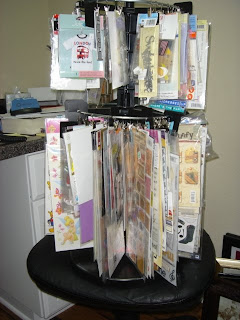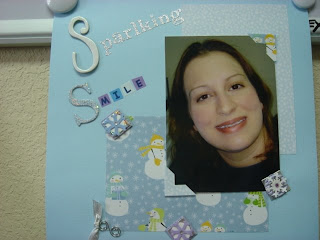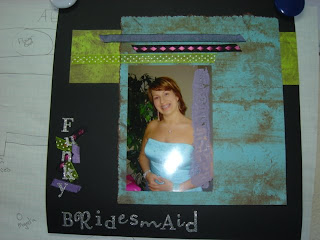I have a friend who said "Everything is so organized. Each thing in it's own little cubby!" I told him , "it's really not!". He said "well, it appears to be". So, what is real organization? How you scrap? How well your tools are stored? How cute your scrapping area looks? Memory Makers covers a lot of different ways to be organized.
1. Sort photos first - Organize your photographs chronologically or by event before scrapbooking to make the creative process go more smoothly. Place photos in photo storage boxes with dividers labeled by month, year, occasion or event.
My old stuff is everywhere! I have some in old albums that need to be dealt with soon. I don't know how safe that stuff from the 60's & 70's is. The more recent stuff is in photo boxes but, is filed haram-scaram! More recently, since the purchase of a digital camera, I keep all photos on a CD until I need to print a picture. That method seems to work best but, then I have to sort through lots of discs to find the right photo.
2. Planning pages - When choosing which photos will go on certain layouts, choose page embellishments at the same time. Place photos with all supplies needed in an empty top-loading page protector or file folder (depending on your organizational system). When y ou are ready to scrapbook, you'll have everything you need.
Actually, this is what I have learned to do. And it seems to work for me. But, I go even further and gather card stock, printed papers, ribbons, stickers, ephemera, etc....(that's probably what they mean by embellishments). It's a really good for crops and retreats.
3. Traveling storage - Many portable supply totes are available to make transporting your supplies to crops easy, including those designed to be checked with airport luggage. Many of these include specific pockets for pens, scissors and other items. If you're on a budget, consider a suitcase on wheels instead.
These are wonderful to have. There are so many on the market it might be hard to choose from. The alternate choice, a suitcase, is an excellent idea. You can purchase many small organizers to hold pens, stamps, punches, and the like and store them all in the suitcase.
4. Heritage organization - When organizing your heritage photos and documents, consider sorting by name or surname, depending on the number of photographs you have. Make sure you choose an organizational method that will be easy for future generations to understand. Apply the same system for memorabilia.
This is something I haven't even begun to tackle. Living and scrapbooking in the here and now seems to consume most of my time. I have a goal set to commit one whole retreat or all day crop to heritage photos. Even just photos of me as a child (talk about heritage!!!).
5. Home storage - Using stackable plastic storage drawers is a good solution for sorting items at home (scissors in one drawer, markers in another, etc.). The drawers are lightweight, inexpensive and large enough to hold many items.
I love the Sterilite 12X12 three drawer storage units. If you watch the Hobby Lobby adds you can get them for 1/2 price. I also like to use clear jars. I have found all of mine at garage sales and flea markets. They hold everything from paint brushes to ribbon scraps. And they look cute. Wicker baskets is also another good choice if you have a room for your crafts and all the storage units show. I also like the three drawer roll-around cart from Sterilite. This fits perfectly under a desk height counter. Last year at "Convention" (that's The Great American Scrapbook Convention" convention for short) I purchased one of my favorite home storage do-dads, the Clip-it-Up!. Here's mine:

It's great for all sizes of stickers and embellishments. It comes with this little opaque boxes to store really small stuff in and you can get a cover which makes transporting really easy.
6. Make notes - When laying out an album or group of pages at once, jot down notes of the journaling you'd like to include on self-stick notes and stick them to the unfinished pages. When it's time to assemble the pages, you'll spend less time organizing your thoughts.
We all need to journal more. Sometimes a title will tell the whole story but, let's try this method and journal more.
7. Keep a supply log - So you don't duplicate scrapbook supplies when buying more, keep a log of all your supplies in your purse. For stamps and punches, simply stamp or punch pages in the log as a visual reminder.
This seems kind of anal!!! But, if your can't remember what you have I guess it would work.
8. Packing for a crop - When gathering supplies to take to a crop, plan the pages you'd like to complete first. Bring only the supplies needed to work on your chosen pages. Leave behind your album (bring only refill pages) and other non-consumable tools (the host will often provide items such as punches, circle cutters, etc.).
I'm not completely behind this...If you have been to the same place to crop before, you know what kind of tools they have. You may still need to bring something special. I do support the idea of planning your pages in advance and bringing only what you need for those pages. Some crops have product for sale. This is alway alluring...and it's good if you have some photos you can't quite find the right paper/embellishments/card stock for in your current stash.
9. Plan now, scrap later - It's a good idea to keep time spent planning page layouts separate from actual srapbooking time. Once you are in the planning mode, it's easier to organize materials and photos for lots of layouts at once. Jumping back and forth from scrapbooking to planning can slow you down.
Enough said.
10. Travel memorabilia - When traveling, bring clear plastic storage bags and label one for every day of your vacation. At the end of each day, place any brochures, admission tickets, postcards, etc., in that bag for easy page organization when you return home.
Another great idea is carry a journal with you to make notes about what you did each day. When you get home and have your memorabilia you may not remember any of the details of that day.
11. Current pictures first - If you are behind on your scrap-booking (or just getting started), begin with your most recently developed photographs. The events will be fresher in your mind and easier to work on.
Great tip! Catch up on your most recent events. You can always do those heritage photos later.
12. Idea books - Develop a system for marking layouts in idea books and magazines to make referencing easier. Photocopy ones you'd like to use and keep them with your supplies, sketch the page and reference the book it's from, or attach self-stick notes to pages you like.
I have just completed my "Idea Book!!". I have three year old scrapbooking magazines that were just getting in the way and I looked through them and pulled out the pages of the techniques, layouts, and other ideas and put them in a three-ring binder. I wrote on the pages the things I liked about the idea/layout. I even found good challenges for myself and others.
13. Colored paper - Sort and organize your paper by color to make it easy to reach for the right shade.
This is easy if you have your paper stored in easy to see holders.
14. Family tree - To start organizing your family tree, use a copy of a fill-in ancestor chart often found in a genealogy book or on the Internet. Start by recording your name, date/place of birth, spouse's name and date/place of marriage. Do the same for your parents and grandparents.
This could be fun. Some libraries offer genealogy classes for free.
Watch for Tools & Supplies next!!!!!!!!!!!














